
A collaboration with UNL researchers that began months before Joseph Francisco was appointed dean of the College of Arts and Sciences was featured on the cover of the July 30 edition of the Journal of the American Chemical Society.
Francisco’s collaboration with UNL’s Xiao Cheng Zeng, Ameritas University professor of chemistry, and Jaeil Bai, research assistant professor of chemistry, demonstrated the potential of hydrogen gas hydrates to exist within the confines of single-walled carbon nanotubes. The research, which began in October when Francisco was William E. Moore Distinguished Professor of Earth and Atmospheric Sciences and Chemistry at Purdue University, was highlighted in JACS Spotlights, a feature developed to make the journal’s research more accessible to the broader community.
Francisco became dean of the UNL College of Arts and Sciences on July 1.
Far beneath the Earth’s surface, fossil fuels are believed to be stored as gas hydrates, which are composed of gas molecules encapsulated within clathrates (cage-like structures made of hydrogen-bonded water molecules). Given their natural ability to grab onto gas molecules, gas hydrates have captured the attention of researchers interested in developing new approaches to carbon sequestration and hydrogen storage, among other applications. Although hydrogen molecules were long believed to be too small to stabilize the host lattice of ice clathrates, hydrogen gas has been demonstrated to form gas hydrates when subject to high pressures, a development that sparked a wave of efforts to develop gas hydrates as a new medium for hydrogen storage.
The team used molecular dynamics simulations to predict that the hydrogen hydrates, stable at near-ambient temperatures, spontaneously form a molecular wire within a one-dimensional nanochannel, and exhibit structures dependent on the width of their single-walled carbon nanotube containers. If confirmed in the laboratory, these structures may lead to the development of large-scale hydrogen storage media.
“I had been following this guy’s (Zeng’s) work for 10 years, so when he called and invited me to come over, I was delighted,” Francisco said. “He had done some really fundamental work in this area and we had been playing around in that area. I saw an opportunity for us to do something that hadn’t been done before. There’s no guarantee that these ideas will work out, but we had the right young man (Bai) to take a look at the problem. He worked very hard on it and yielded some really fruitful results.
“What excited me the most was the potential to have a big impact. If experiments verify this work, it could really be a game-changer.”








